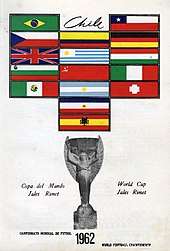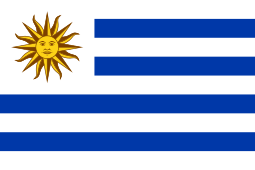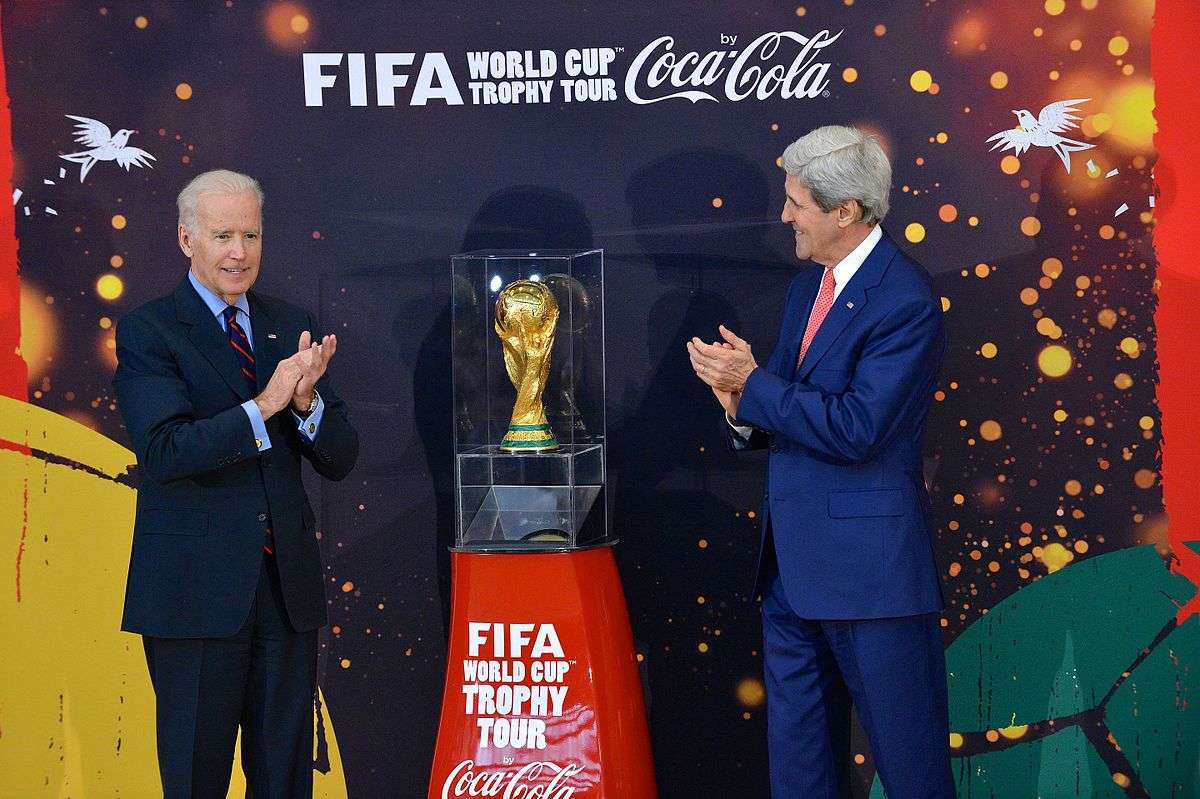FIFA World Cup Trophy
The World Cup is a gold trophy that is awarded to the winners of the FIFA World Cup association football tournament. Since the advent of the World Cup in 1930, two trophies have been used: the Jules Rimet Trophy from 1930 to 1970, and the FIFA World Cup Trophy from 1974 to the present day.
| FIFA World Cup Trophy | |
|---|---|
FIFA World Cup Trophy, presented since 1974 | |
| Given for | Winning the FIFA World Cup |
| Presented by | FIFA |
| History | |
| First award | 1930 (Jules Rimet Trophy) 1974 (FIFA World Cup Trophy) |
| Most wins |
|
| Most recent | |
| Website | Fifa.com |
The first trophy, originally named Victory, but later renamed in honour of FIFA president Jules Rimet, was made of gold plated sterling silver and lapis lazuli and depicted Nike, the Greek goddess of victory. Brazil won the trophy outright in 1970, prompting the commissioning of a replacement. The original Jules Rimet Trophy was stolen in 1983 and never recovered.
The subsequent trophy, called the "FIFA World Cup Trophy", was introduced in 1974. Made of 18 carat gold with bands of malachite on its base, it stands 36.8 centimetres high and weighs 6.1 kilograms.[1] The trophy was made by Stabilimento Artistico Bertoni company in Italy. It depicts two human figures holding up the Earth. The current holders of the trophy are France, winners of the 2018 World Cup.
Jules Rimet Trophy

The Jules Rimet Trophy was the original prize for winning the FIFA World Cup. Originally called "Victory", but generally known simply as the World Cup or Coupe du Monde, it was renamed in 1946 to honour the FIFA President Jules Rimet who in 1929 passed a vote to initiate the competition. It was designed by French sculptor Abel Lafleur and made of gold-plated sterling silver on a lapis lazuli base.[2] In 1954 this base was replaced with a taller version to accommodate more winner's details. It stood 35 centimetres (14 in) high and weighed 3.8 kilograms (8.4 lb).[3] It comprised a decagonal cup, supported by a winged figure representing Nike, the ancient Greek goddess of victory. The Jules Rimet Trophy was taken to Uruguay for the first FIFA World Cup aboard the Conte Verde, which set sail from Villefranche-sur-Mer, just southeast of Nice, on 21 June 1930. This was the same ship that carried Jules Rimet and the footballers representing France, Romania, and Belgium who were participating in the tournament that year. The first team to be awarded the trophy was Uruguay, the winners of the 1930 World Cup.[4]
During World War II, the trophy was held by 1938 champion Italy. Ottorino Barassi, the Italian vice-president of FIFA and president of FIGC, secretly transported the trophy from a bank in Rome and hid it in a shoe-box under his bed to prevent the Nazis from taking it.[5] The 1958 FIFA World Cup in Sweden marked the beginning of a tradition regarding the trophy. As Brazilian captain Hilderaldo Bellini heard photographers' requests for a better view of the Jules Rimet Trophy, he lifted it up in the air. Every Cup-winning captain ever since has repeated the gesture.[6]
.jpg)
On 20 March 1966, four months before the 1966 FIFA World Cup in England, the trophy was stolen during a public exhibition at Westminster Central Hall.[7] It was found just seven days later wrapped in newspaper at the bottom of a suburban garden hedge on Beulah Hill, Upper Norwood, South London, by a black and white mongrel dog named Pickles.[8][9]
As a security measure, The Football Association secretly manufactured a replica of the trophy for use in exhibitions rather than the original. This replica was used on subsequent occasions up until 1970 when the original trophy had to be handed back to FIFA for the next competition. Since FIFA had explicitly denied the FA permission to create a replica, the replica also had to disappear from public view and was for many years kept under its creator's bed. This replica was eventually sold at an auction in 1997 for £254,500, when it was purchased by FIFA. The high auction price, ten times the reserve price of £20,000–£30,000, was led by speculation that the auctioned trophy was not the replica trophy but the original itself. Subsequent testing by FIFA, however, confirmed the auctioned trophy was indeed a replica[10] and FIFA soon afterwards arranged for the replica to be lent for display at the English National Football Museum, which was then based in Preston but is now in Manchester.[11]
The Brazilian team won the tournament for the third time in 1970, allowing them to keep the real trophy in perpetuity, as had been stipulated by Jules Rimet in 1930.[12] It was put on display at the Brazilian Football Confederation headquarters in Rio de Janeiro in a cabinet with a front of bullet-proof glass.[13]
On 19 December 1983, the wooden rear of the cabinet was opened by force with a crowbar and the cup was stolen again.[14] Four men were tried and convicted in absentia for the crime.[15] The trophy has never been recovered, and it is widely believed to have been melted down and sold.[16] Only one piece of the Jules Rimet Trophy has been found, the original base which FIFA had kept in a basement of the federation's Zürich headquarters prior to 2015.[17]
The Confederation commissioned a replica of their own, made by Eastman Kodak, using 1.8 kilograms (4.0 lb) of gold. This replica was presented to Brazilian military president João Figueiredo in 1984.[15] The trophy was the subject of a 2014 documentary "Mysteries of the Rimet Trophy" shown as part of ESPN's 30 for 30: Soccer Stories films series during the 2014 World Cup.[18]
New trophy

A replacement trophy was commissioned by FIFA for the 1974 World Cup. Fifty-three submissions were received from sculptors in seven countries.[16][19] Italian artist Silvio Gazzaniga was awarded the commission. The trophy stands 36.5 centimetres (14.4 in) tall and is made of 5 kilograms (11 lb) of 18 carat (75%) gold, worth approximately US$161,000 in 2018, with a base 13 centimetres (5.1 in) in diameter containing two layers of malachite. It has been asserted by Sir Martyn Poliakoff of Periodic Videos that the trophy is hollow; if, as is claimed, it were solid, the trophy would weigh 70–80 kilograms (150–180 lb) and would be too heavy to lift.[20][21] Produced by Bertoni, Milano in Paderno Dugnano, it weighs 6.175 kilograms (13.61 lb) in total and depicts two human figures holding up the Earth. Gazzaniga described the trophy thus, "The lines spring out from the base, rising in spirals, stretching out to receive the world. From the remarkable dynamic tensions of the compact body of the sculpture rise the figures of two athletes at the stirring moment of victory".[16] Miguel Delaney, football writer for The Independent, wrote, "Those two arms on the trophy "stretching out to receive the world... at the stirring moment of victory" – in the words of designer Silvio Gazzinaga – are so representative in more ways than one. This is what everyone in the game is ultimately reaching for: immortality.”[22]
The trophy has the engraving "FIFA World Cup" on its base. After the 1994 FIFA World Cup a plate was added to the bottom side of the trophy on which the names of winning countries are engraved, names therefore not visible when the trophy is standing upright. The inscriptions state the year in figures and the name of the winning nation in its national language; for example, "1974 Deutschland" or "1994 Brasil". In 2010, however, the name of the winning nation was engraved as "2010 Spain", in English, not in Spanish.[23][24] As of 2018, twelve winners have been engraved on the base. The plate is replaced each World Cup cycle and the names of the trophy winners are rearranged into a spiral to accommodate future winners, with Spain on later occasions written in Spanish ("España").[16] FIFA's regulations now state that the trophy, unlike its predecessor, cannot be won outright: the winners of the tournament receive a bronze replica which is gold-plated rather than solid gold.[16] Germany became the first nation to win the new trophy for the third time when they won the 2014 FIFA World Cup.[25]
Winners
Jules Rimet Trophy
.svg.png)

.svg.png)


FIFA World Cup Trophy







See also

References
- "CBCSports". Retrieved 23 May 2014.
- "Guardian". Retrieved 29 November 2018.
- "Jules Rimet Cup". FIFA. Archived from the original on 18 March 2013. Retrieved 1 August 2014.
- Burnton, Simon (13 May 2014). "World Cup: 25 stunning moments … No 16: Conte Verde's trip to Uruguay". The Guardian. Retrieved 6 July 2015.
- Sportskeeda (2018). "History of World Cup". Sportskeeda. Retrieved 5 February 2018.
- "Blatter mourns loss of ex-Brazil captain Bellini". FIFA. 21 March 2014. Archived from the original on 5 March 2016. Retrieved 6 July 2015.
- "1966: Football's World Cup stolen". BBC News. 20 March 1966. Retrieved 28 June 2010.
- Reid, Alastair (10 September 1966). "The World Cup". The New Yorker. Archived from the original on 24 February 2007. Retrieved 2 February 2007.
- Dean, Jon (18 March 2016). "How my dog found the stolen World Cup trophy – put me in the frame". Retrieved 8 March 2018.
- Simon Kuper (2006). "Solid gold mystery awaits the final whistle". Financial Times. Retrieved 5 July 2006.
- “Jules Rimet Trophy Returns To Museum Display”. National Football Museum. Retrieved 6 March 2018
- Mark Buckingham (2006). "1970 World Cup – Mexico". Sky Sports. Archived from the original on 13 October 2006. Retrieved 2 October 2006.
- “World Cup mystery: what happened to the original Jules Rimet trophy?”. The Guardian. Retrieved 6 March 2018
- Bellos, Alex (2003). Futebol: The Brazilian Way of Life. London: Bloomsbury. pp. 342. ISBN 0-7475-6179-6.
- "Trophy as filled with history as Cup". CNN. Associated Press. 22 June 2002. Archived from the original on 29 April 2011. Retrieved 5 July 2006.
- "The FIFA World Cup Trophy". FIFA. Retrieved 19 February 2016.
- "World Cup: Piece of original Jules Rimet trophy found". 13 January 2015. Retrieved 6 July 2015.
- Mysteries of the Rimet Trophy, ESPN
- "Classic Football History of the FIFA World Cup". FIFA. Retrieved 30 June 2014.
- Periodic Videos. "Chemistry of the World Cup Trophy". Retrieved 5 June 2010.
- "Professor says World Cup trophy cannot be solid gold". BBC News. 12 June 2010. Retrieved 13 June 2010.
- "A riot of colour, emotion and memories: the World Cup stands alone in the field of sport". The Independent. Retrieved 20 August 2018.
- "Taça da Copa do Mundo chega ao Brasil (World Cup trophy arrives in Brazil)". Globo TV. 21 April 2014. Retrieved 22 April 2014.
- "Alemanha x Argentina – AO VIVO". UOL. 13 July 2014. Retrieved 14 July 2014.
- "Germany v Argentina: World Cup final champions not allowed to keep trophy - despite becoming three-time winners". The Telegraph. 6 July 2018.
External links
| Wikimedia Commons has media related to FIFA World Cup trophy. |
